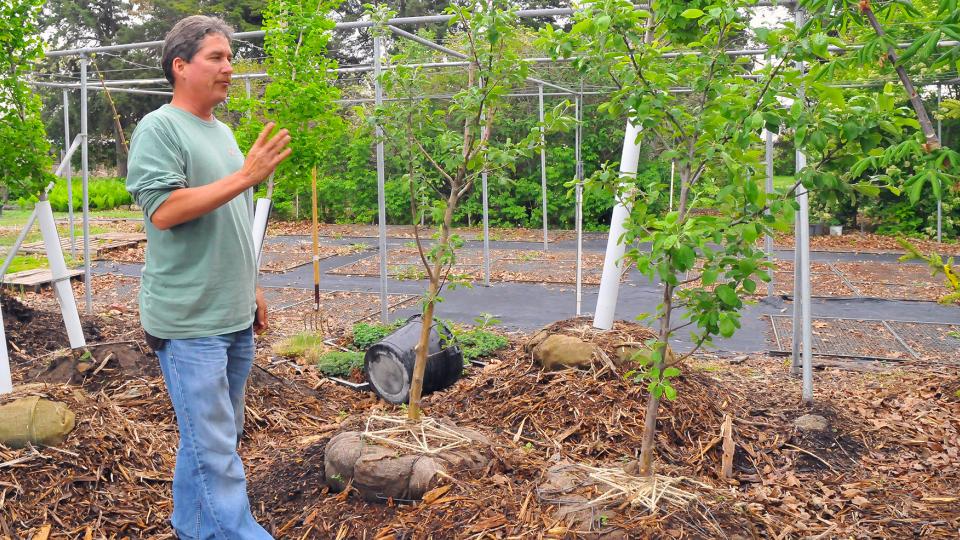
A few of UNL's oldest residents are being genetically duplicated inside a nondescript white building tucked away in a quiet corner of East Campus.
But, rather than cloning the chancellor for another term or a favorite crusty professor to lead lectures, the project is preserving UNL's historic trees, growing duplicates of existing arbors to be planted and enjoyed by future generations.
Landscape Services is leading the work, with Laurence Ballard, nursery director, overseeing the cloning process.
"This work is one of the most rewarding parts of my job," Ballard said. "I have a passion for plants and appreciate the story and history behind everyone. It's great to be able to preserve these trees for the future."
Most recently, Ballard successfully cloned and replanted two Flower of Kent trees by Jorgensen Hall on May 5. The saplings are duplicates of the Newton apple tree located on the southwest corner of Behlen Laboratory. That tree is itself a genetic duplicate to the apple tree that inspired Sir Isaac Newton's theory on gravity.
Physics and astronomy celebrated the new Flower of Kent trees with spring semester graduates on May 7.
When physics and astronomy moved into Jorgensen Hall in 2010, administrators hoped to move the Flower of Kent tree to the new building. Unfortunately, the tree was too big to relocate, so Ballard started working to clone it.
He used a chip budding technique, which removes a shield-shaped chip from a sapling that will be used for rootstock and replaces it with a same-sized piece that includes a bud from the tree desired for duplication. The piece is taped to the exposed part of the root tree and — if done correctly — will start to grow within about two weeks.
"The closer you match the chip, the better your chance of success," Ballard said. "It's a technique I first learned in Australia, then relearned here at UNL during a propagation class led by Bill Gustafson."
He also used UNL Extension NebGuide, "Chip Budding: An Old Grafting Technique for Woody Plants with Rediscovered Advantages for Nebraska," written by Gustafson, a retired horticulture professor, and Todd Morrissey, as a refresher.
The two trees planted outside Jorgensen Hall were budded in September 2011 and planted in the Landscape Services nursery in 2012. They are between five and six feet tall and about an inch and a half in diameter.
Dan Claes, professor and chair of physics and astronomy, said the department is excited to have the Flower of Kent trees planted and growing next to its building.
"People would always stop and marvel that we had an actual Newton apple tree," Claes said. "And, it made for a nice photo opportunity for visitors and tours. It just really has a great story that allows everyone to connect with Newton and his highly abstract theory."
That first tree was planted at UNL in 1991. It was grown via a cutting from the very tree believed to be the one that dropped an apple and inspired Newton to develop his theories on gravity. Read more about the history behind the tree at http://go.unl.edu/8fqa.
Ballard said a third Flower of Kent tree — which needs more time to grow — might be added to the green space west of Jorgensen Hall in the fall or spring.
Other trees that Ballard has successfully duplicated/grown from clippings or seed include the giant cottonwood in Maxwell Arboretum; a Russian oak south of the Dairy Store; a horse chestnut in the arboretum; a tree lilac planted by Charles Bessey; and a bald cypress by Biochemistry Hall.
He's also trying to clone a Chinese juniper in the arboretum that was a favorite of his father.
"My dad was an English professor and a Native American," Ballard said. "He used to take walks through the arboretum and his favorite tree — which he said was the biggest in the arboretum at the time — was this Chinese juniper. It's pretty beat up now, so I decided to get some cuttings and try to grown a new one."
He counted just one success in his first 200 attempts. It grew for a short time, but died. He gathered seeds from the tree and now has two growing specimens. He also plans to try to grow more from cuttings later this year.
"All aspects of propagation — from little plants to big trees — is so rewarding," Ballard said. "We could always purchase and plant new trees as replacements. But, it's more fun to put in a little extra work and add another chapter to the live of UNL's plants and trees."
— Troy Fedderson, University Communications